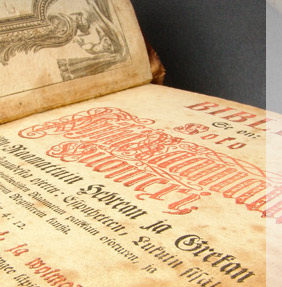


The website is divided into eight sections:
The front page has links to various information on Vvks and on Old Finnish.
The Abbreviations part of this section is a key to the references in the texts as well as to abbreviated forms, such as acronyms, and special characters used in the material. The Orthography part gives an overview of Mikael Agricola's alphabet and the pronunciation of the characters. The section briefly describes the development of orthography after Agricola.
The section begins with a prologue that tells of the time prior to written Finnish. The period of Old Literary Finnish from Mikael Agricola to the end of the 17th century is divided into the time before and the time after the first printed Bible of 1642, whereas 18th century literature is divided into several genres. The overview closes with an epilogue summing up 18th century developments. All parts of the literature overview have clickable images from old Fennica and links to the Doria material of the National Library.
The bibliography does not contain the sources of the texts, i.e., the original works, but only other sorts of references. The abbreviated references appearing in the examples of the grammar section are explained in the Abbreviations and Orthography section.
The oldest text samples are those by Mikael Agricola and his contemporaries in the 16th century (Paragraphs 1 and 2). Seventeenth century texts consist of religious prose (Paragraph 3), legal language (4), lyrics (5) and some samples of everyday Finnish (6). Eighteenth century texts are divided into five genres: short prose (7), articles in almanacs (8), legal and newspaper language (9), lyrics (10), and various other text (11). Some of the texts are linked to the original version of the work/page in either a scanned or digitized form. For text samples 1, 4B, 7, 8, 10, 27 and 30, there are audio snippets.
Explanations can be read by clicking on a superscript number after the word or phrase. Explanations open in a pop-up window, and they are all listed consecutively in the same pop-up window so the user can read all the references one by one by scrolling down the text in the window. Alternatively, the user can click on the references separately, with explanations of the various items opening in new pop-up windows. An explanation often contains a number or is just a number or numbers. This means that the item relates to a grammatical explanation, and the number guides the reader to the key paragraph in the grammar section.
Chapters 1 to 12 of the Phonology and Morphology section deal with phonology, Chapters 13 to 23 with morphology and vocabulary. Links in the texts guide the user to grammatical explanations and related information in the Phonology and Morphology and Syntax sections. The chapters, tables and examples of the two sections are interlinked when needed. The abbreviated references in the examples are explained in the Abbreviations and Orthography section.
Syntax (Paragraphs 24-41) is a direct continuation of the Phonology and Morphology section of the site. Syntax includes hundreds of examples as well as 30 tables in which Old Finnish is compared with present-day Finnish. Links in the texts guide the user to read grammatical explanations and related information in the Phonology and Morphology and Syntax sections. The chapters, tables and examples of the sections are interlinked when necessary. The abbreviated references in the examples are explained in the Abbreviations and Orthography section.
This section consists of 18 articles by Pirkko Forsman Svensson on eighteenth century Finnish, published in the years 1998—2003. The links provide information of the original publication, i.e. a book or a periodical.
In the Exercises section you can check your knowledge of the various fields of Old Literary Finnish. You can train your interpretation of 16th century orthography (1), phonology and morphology (2, 4), or syntax and vocabulary (3). There is a total of some seventy exercises. You can view the source texts of some of the exercises by clicking and check your answers in the Key to Exercises. The source texts of exercises 4, 7, 9 and 10 are recorded as audio, so you can listen to the pronunciation of the sounds.